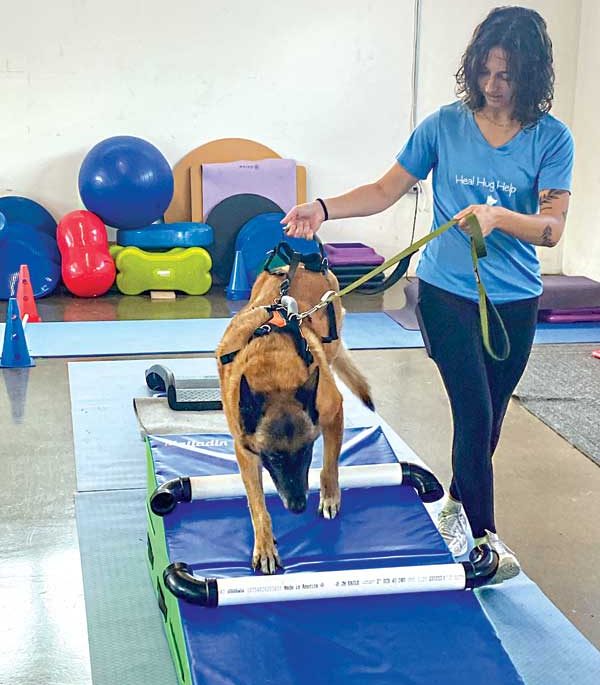
There has been exponential growth in the range of physical rehabilitation treatments and their availability for pets, as well as a greater variety of lifestyle products to improve physical well-being around the home.
This mainstream approach to pet rehabilitation is being fueled by the current industry mindset that the slew of new veterinary technology and equipment and lifestyle products for home use are offering viable alternatives to medications to increase mobility, reduce pain, and enhance recovery processes. Further, pet rehabilitation is being embraced by pet parents, particularly those who have experienced the benefits of physical therapy and improved quality of life for themselves.
Hydrotherapy and more
“As with human physical medicine, pet rehabilitation has found its place and stride,” says David Levine, PT, PhD, DPT, Diplomate American Board of Physical Therapy Specialties (Orthopedics), CCRP, Cert. DN. He is also adjunct professor at the University of Tennessee’s College of Veterinary Medicine and North Carolina State University’s College of Veterinary Medicine and co-chair the University of Tennessee’s Certificate Program in Canine Rehabilitation.
“Animals take to it pretty well. It’s a calming field. We are trying to use a fear-free approach to work with both pet and owner to achieve improvement in a pet’s general well-being,” Dr. Levine says.
Back in the ‘90s, Levine and his colleague Darryl L. Millis, DVM, DACVS, CCRP, DACVSMR professor of orthopedic surgery, director of CARES (Canine Arthritis, Rehabilitation, Exercise and Sports Medicine) Acree Endowed Professor of Veterinary Medicine at the University of Tennessee, pioneered the first underwater treadmill for pets, which has become an essential piece of exercise equipment for pet rehabilitation. “At the time, there was only one company making the equipment for humans,” Levine says. “They helped to develop another model with a longer belt that also catered for a lower water level to accommodate smaller pets. Prior to that, we were swimming dogs in a pool. But swimming is not a natural, everyday activity for animals. So, even if they are being held up, they get exhausted quickly. But with hydrotherapy, just being able to walk in the water allows a pet to exercise for a much longer period.”
Levine says walking in water is calming and stress-free for patients, and has several uses, from orthopedic and neurological pathologies to weight loss and conditioning to prevent osteoarthritis. Further, hydrotherapy can help with improving function and lessening pain for pets already suffering from joint disease.
While most patients are dogs, hydrotherapy can be used to benefit cats, as well as small critters, such as guinea pigs and tortoises.
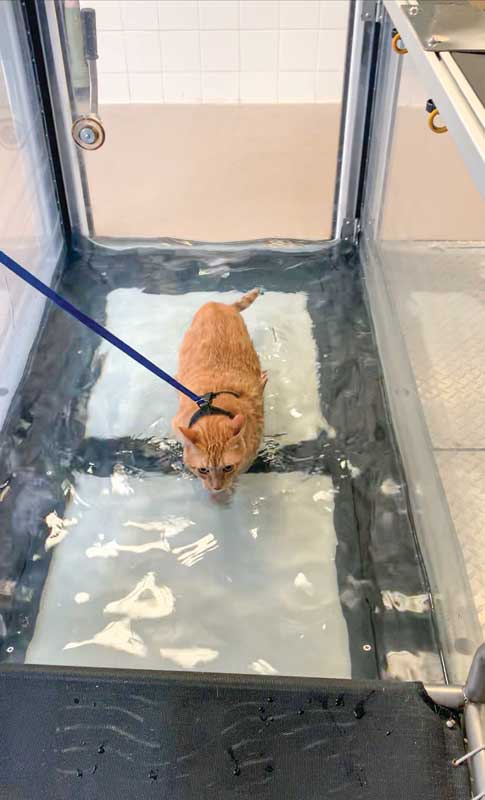
Wendy Davies, BS, CVT, CCRVN, VTS (Physical Rehabilitation), who has spent the past 15 years practicing pet rehabilitation at the University of Florida (UF) Small Animal Rehabilitation and Fitness Center, says about five percent of her patients are feline, and that number is increasing as pet parents become more aware 90 percent of cats over the age of 10 years suffer from arthritis.
“Most of the cats I treat have orthopedic issues, such as elbow and knee arthritis, patella luxations, and back pain,” says Davies. “I’ve had patients that have had a vascular event like a saddle thrombus where we need to retrain the cat’s gait as well as provide pain management. I’ve seen neurological issues, too. We often perform laser therapy, therapeutic ultrasound for sore, tight muscles, heat and massage, acupuncture and maybe exercises depending on how the cat is tolerating therapy that day.” Davies says cats can also tolerate hydrotherapy. “However, we let the cat dictate the therapy and the time spent. If the cat is done for the day, its done, and we try again at the next appointment,” she says.
Making space for rehab
To offer a comprehensive range of rehabilitation treatments and exercises, it requires a large open space to accommodate the equipment needed. Consequently, there are various “floor models” within the veterinary community to offer rehab exercise programs and treatments.
Many veterinary practices begin by designating rooms to offer technology-based treatments, such as laser, ultrasound, pulsed electromagnetic field (PEMF) therapy, massage, and basic range of motion exercises.
However, there has been an increase in specialty hospitals opening nationwide that have a designated rehabilitation area for their own patients, and those referred from other clinics.
Other options include clinics at teaching hospitals and standalone rehabilitation centers, such as the University of Florida Small Animal Rehabilitation and Fitness Center where Davies works.
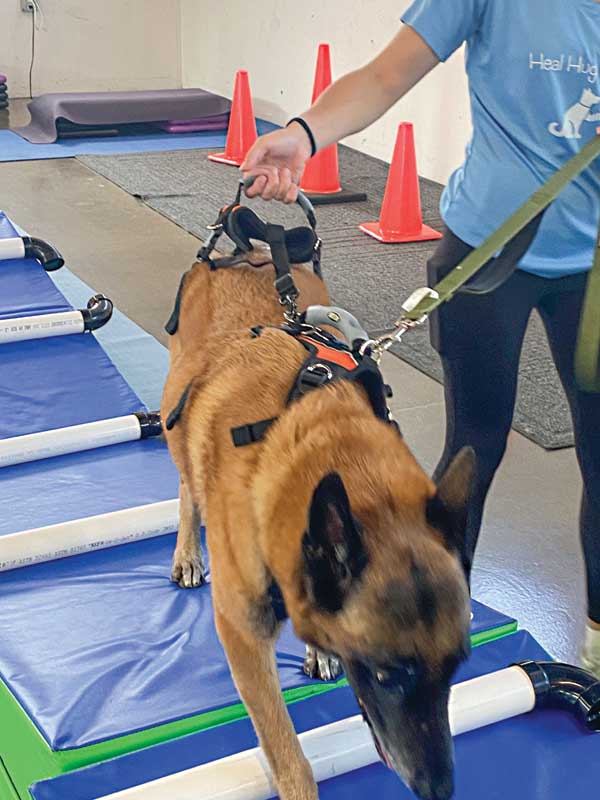
Another sign that pet rehabilitation is mainstream, is the growing number of standalone rehabilitation centers nationwide.
Lauryn Harker, RVT, CCRP, owner of the Canine Rehabilitation of Orange County (CROC), chose to open her business in a spacious commercial building in Santa Ana, Calif. There are several individual treatment rooms and a large open space set up with equipment, such as Cavaletti poles, sections of different soft and hard walking surfaces, both flat and raised, a complete range of balance pads and balls, and two hydrotherapy treadmills.
“The area is especially designed to have a peaceful spa-like vibe,” Harker explains. Big orthopedic mattresses on the side of the workout area are equipped with heating pads and dogs start a session here before being taken through their exercise paces or a hydrotherapy session.
“The dogs sense the calm atmosphere; there is no stressful barking or whining,” she adds.
Harker is strict about not letting pet parents into the exercise room to avoid distraction. All sessions are customized for the visit for a flat rate of $90 an hour per session.
“This is done so pet parents aren’t choosing treatments they can afford over a therapy that may be better for the pet,” she explains. “Fortunately, all the major pet insurance companies pay for rehabilitation. So, effectively, pet parents end up paying only 10 per cent of the total cost.”
Where certain patients need intense and regular treatments for their recovery, another option is for them to board at a facility for the duration of their customized program. The Aqua Animal Care Center in Oceanside, Calif., and its affiliated practice the Companion Animal Wellness Center is Carlsbad, Calif., offer this option, as well as a day care program where patients are dropped off in the morning and picked up at the end of the day.
“If a patient is staying with us, we can work with them throughout the day (with shorter more frequent sessions) as some dogs need multiple rehabilitation sessions, involving different treatments,” says Gabriella Varcoe DVM, DACVSMR, CCRP, CVA, CVPP.
“The day care option works with special needs dogs that also require medication and need someone on hand to help go to the bathroom. It can be difficult if the owner is at work all day to handle this. Rehabilitation therapy is a commitment,” she adds.
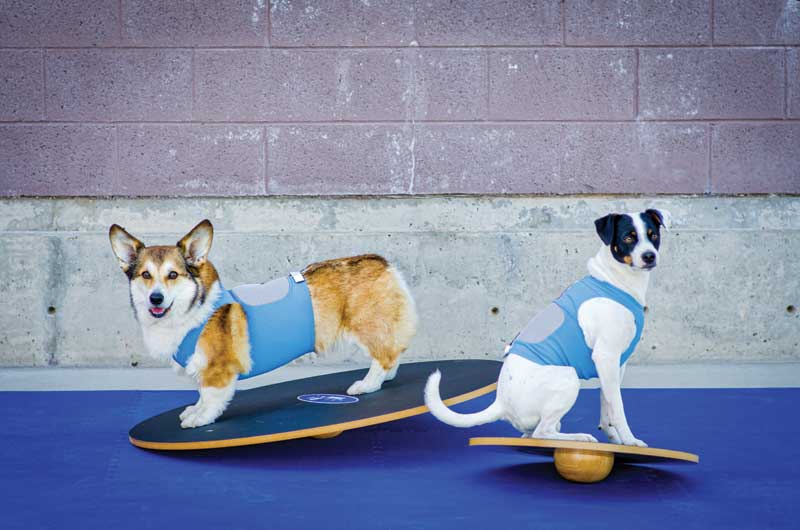
A team effort
The success of a rehabilitation program depends on client cooperation by following up with exercises and stretching routines at home. Both veterinarians and rehab therapists encourage such involvement for a better overall outcome.
Harker adds she has an arsenal of about 200 different exercises/movements that target specific physiological deficits to involve pet parents when it comes to homework for their pets.
“My home programs are designed to make it easy on a pet’s family so that it isn’t seen as a chore. I love it when kids can get involved, too,” she says. In a typical home plan, target exercises can be built into a walk or cuddle time on the couch. “For example, I’ll suggest the dog walks on grass instead of concrete. They can include figure eights around bushes and trees and negotiate both flat surfaces and slight inclines without the dog even realizing that it’s getting some therapy during outside play time or a walk. Doing a sit-to-stand command with a treat, is a great functional exercise for a dog, too,” Harker adds.
Davies also gives homework for her feline patients: “We need the owners to be involved for a better outcome by doing some basic exercises, massage or stretching. Just as with humans, cats should keep moving and not remain sedentary to keep their joints happy and healthy,” she explains.
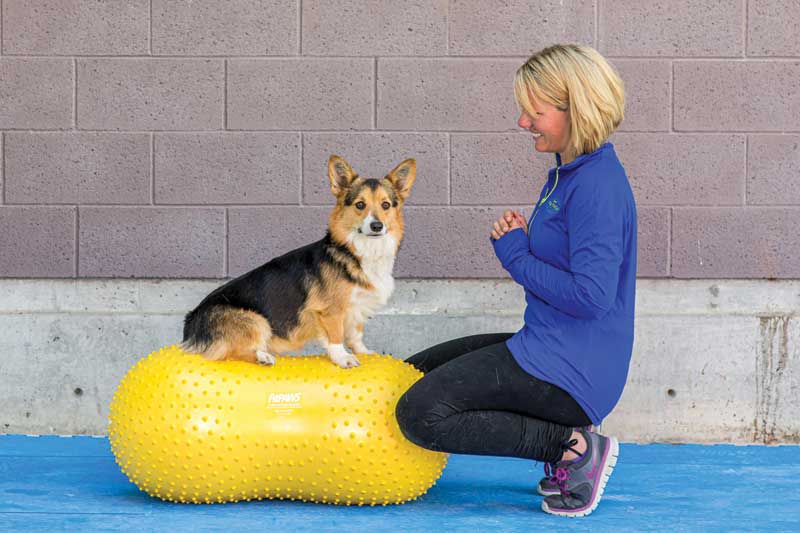
Beyond the clinic
Basic lifestyle changes around the home can be highly beneficial to a pet with physiological issues. A quality memory foam bed can help pets recovering from surgery or suffering from joint and circulation issues.
Therapy pads also offer relief for conditions such as post-operative inflammation, as well as general support for aching joints and aiding improved blood circulation.
Pet stairs and ramps are ideal to give pets access to favorite sleep zones such as couches and beds.
With specific regard to cats, Davies says: “I sometimes also recommend elevated food bowls and low-entry litter boxes. It’s also a good idea to try to limit jumping up and down off taller areas” she says. “Tiny changes can go a long way to relieve pain.”
Sandy Robins is an award-winning multi-media pet lifestyle expert, writer, and pet industry spokesperson. Robins has authored four books, including The Original Cat Bible. She is besotted pet parent to two very opinionated cats, granny to a goofy dog, and auntie to every pet in her neighborhood.
